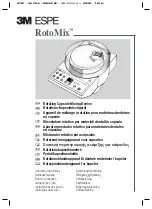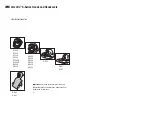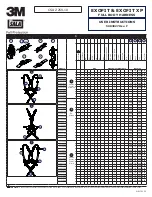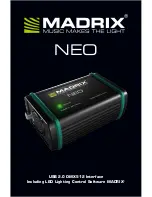
WavePro 7Zi
467
WP700Zi-OM-E-RevA
Notes on Using Channel Emulation without Reference
1.
Sequenced Amplitude Margin (SAM) is used by the Viterbi detector to decide whether a bit should be "1" or
"0". As the Viterbi detector receives each sample, the detector must choose between two possible
sequences, which lead to the state it selects. The sequence with the best fit determines which state is
selected. SAM indicates how much better the surviving sequence is than the one that is discarded from
further consideration. "0" means the Viterbi Detector has no preference at all between the sequence it
chose and one it threw away at a particular sample. The most positive value is the square of the "minimum
error distance" for the selected Signal Type, and implies excellent certainty about which sequence to keep.
SAM values are associated with the sample leaving the Viterbi detector's trellis, that is, the sample about
which the final decision is being made. The SAM includes the effect of all previous samples in the block
and of the following samples that are already in the trellis.
Near-zero SAM values are due to distortions in the shape of the head signal. Problems causing distortions,
which Channel Emulation without Reference can find, include media defects and dropouts, asperities,
noise bursts, or a bad head. (Noise bursts are sometimes obscured by the equalization filter, and result in
a distorted shape of a pulse. To see if this is the cause of a distorted shape, look at the unfiltered waveform
also.) Without a reference Channel Emulation without Reference does not know if the decisions it makes
actually correspond to what was written, it only knows how good the head signal looks when the disk is
read. As an example, suppose a disk occasionally simply fails to write several transitions, resulting in a flat
area in the head signal. All the pulses are the correct shape, it’s just that some aren’t there at all. This can
still be caught if it causes a Run Length Limit violation and that check was enabled, but it might not be a
problem for the Viterbi detector.
2.
When checking for run length limit (RLL) violations, "k" of the RLL code "m/n(d,k)" must be specified: "k" is
the maximum number of non-transitions between transitions. When
Run Length Limit
is set to a non-zero
value, Channel Emulation without Reference also counts the number of non-transitions in a row and
checks against the user specified limit. Examples: we recommend that k be set to 8 to handle 8/9(0,4,4)
codes; set k to 7 for 2/3(1,7) modulation code.
3.
d
is the minimum number of non-transitions between transitions. When d=0, adjacent transitions are
allowed. When d=1, adjacent transitions are not permitted. For E2PR4 it can also be set to d=2. A non-zero
d
eliminates several possible sequence choices (states and transitions in the Viterbi detector). If set to
1
when it should be
0
, Channel Emulation without Reference will almost certainly detect a large number of
"errors." If set to
0
when it should be
1
, it is possible that Channel Emulation without Reference will pass a
few bits that should have been flagged as errors.
Channel Emulation with Reference
Whereas Channel Emulation without Reference acquires a single trace and makes a prediction of problems
based on signal quality, when the method is used with a reference signal, it calculates the Viterbi output of the
reference, as well as that of the acquired trace, and compares the two to find mismatches.
Channel Emulation with Reference starts by finding the beginning of the sector. The algorithm looks at the head
signal beginning at the Read Gate true transition (or analyze region start if Read Gate is not available) and tries to
synchronize to the VCO Synch pattern in order to establish sampling phase and expected sample levels. To
accomplish this, Channel Emulation with reference requires that
VCO Synch Pattern
be set correctly, and that
the
Bit Cell Time
be approximately correct. Because the position of Read Gate relative to the head signal can
jitter from read to read, the method aligns the two bit streams it is comparing based on the end of the repetitive
VCO Synch pattern. If there is an error within the VCO Synch pattern, this will be found, but the method may also
find many other mismatches if incorrectly aligned.
The data is then passed through the emulated channel where it is appropriately sampled. The sampled output
enters the Viterbi detector, which chooses the "sequence" of bits (history) that is the most likely when the new bit
due to this sample is appended.
SAM is the margin between keeping and rejecting the correct state in the sequence, at any point. Channel
Emulation
without
reference essentially assumes that the output of the Viterbi detector is "correct," and gives the
margin between that and a different decision at each bit position. It must do this because it does not have a
reference. Therefore SAM results are always greater than zero from Channel Emulation without reference; they
are the margin from the final decision to some other decision.
Channel Emulation
with
reference performs channel emulation on the reference signal when it is stored and
saves the resulting bit sequence. When "Emulation" is turned on it performs channel emulation on each
Содержание DDA 7 Zi series
Страница 1: ...Operator s Manual WavePro SDA and DDA 7 Zi Series Oscilloscopes ...
Страница 2: ... L R R H HUD RU D D ...
Страница 41: ...Operator s Manual WP700Zi OM E RevA 40 The detachable WavePro Zi front panel ...
Страница 376: ...WavePro 7Zi 375 WP700Zi OM E RevA Absolute Offset Relative ...
Страница 439: ...Operator s Manual WP700Zi OM E RevA 438 ...
Страница 440: ...WavePro 7Zi 439 WP700Zi OM E RevA ...
Страница 544: ...Thank you for purchasing a WavePro SDA or DDA 7 Zi Oscilloscope ...
















































